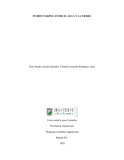Mostrar el registro sencillo del Documento
Puerto Nariño: entre el agua y la tierra
| dc.contributor.advisor | Sánchez Pinzón, Iván Darío | |
| dc.contributor.author | Anzola Gonzalez, Yuly Natalia | |
| dc.contributor.author | Rodríguez Arias, Daniel Leonardo | |
| dc.date.accessioned | 2023-01-18T21:59:53Z | |
| dc.date.available | 2023-01-18T21:59:53Z | |
| dc.date.issued | 2022 | |
| dc.identifier.uri | http://hdl.handle.net/11396/7486 | |
| dc.description | El ecoturismo se ha convertido en una forma de desarrollo económico en Colombia debido a que el país cuenta con características que permiten su práctica. El departamento del Amazonas ha basado históricamente su economía en el comercio, aunque en los últimos años se ha mostrado una tendencia creciente hacia el ecoturismo como una fuente más de ingresos, fruto de la fusión de diversos elementos naturales y del entorno propicio con el que cuenta el departamento para esta iniciativa. Es una herramienta que aporta a la conservación, al sostenimiento de las comunidades indígenas y a estimular el desarrollo tanto en áreas urbanas como en áreas rurales. Por tanto, el proyecto pretende que Puerto Nariño, segundo municipio del Amazonas, debido a su ubicación geográfica estratégica, a las diferentes dinámicas sociales que allí albergan, a la arquitectura característica, y a las dinámicas de borde que presenta, poner en puesta la iniciativa del ecoturismo. Así pues, es necesario diseñar un frente de agua que mitigue el impacto que sufren las infraestructuras urbanas situadas en la cabecera del municipio por causa de las inundaciones, generando cohesión social e identidad urbana, que, articulado a un equipamiento multifuncional, potencialice el turismo y funcione como espacio de intercambio cultural, entre los turistas y las poblaciones anfitrionas, para lograr un desarrollo eco-turístico, que sea inclusivo, sostenible y resiliente. | spa |
| dc.description.abstract | Ecotourism has become a form of economic development in Colombia because the country has characteristics that allow its practice. The department of Amazonas has historically based its economy on commerce, although in recent years there has been a growing trend towards ecotourism as another source of income, as a result of the fusion of diverse natural elements and the favorable environment that the department has for this initiative. It is a tool that contributes to conservation, sustaining indigenous communities and stimulating development in both urban and rural areas. Therefore, the project intends that Puerto Nariño, second municipality of the Amazon, due to its strategic geographic location, the different social dynamics that it hosts, the characteristic architecture, and the dynamics of the border that it presents, put in place the initiative of ecotourism. Thus, it is necessary to design a water front that mitigates the impact suffered by the urban infrastructure located in the head of the municipality due to flooding, generating social cohesion and urban identity, which articulated to a multifunctional equipment, potentiates tourism and functions as a space for cultural exchange between tourists and host populations, to achieve an eco-tourism development, which is inclusive, sustainable and resilient. | spa |
| dc.language.iso | spa | |
| dc.publisher | Universidad La Gran Colombia | spa |
| dc.rights | Attribution-NonCommercial-NoDerivatives 4.0 International | * |
| dc.rights.uri | http://creativecommons.org/licenses/by-nc-nd/4.0/ | * |
| dc.subject | Ecoturismo | spa |
| dc.subject | Frente de agua | spa |
| dc.subject | Intercambio cultural | spa |
| dc.subject | Economía | spa |
| dc.title | Puerto Nariño: entre el agua y la tierra | spa |
| dc.subject.lemb | Arquitectura y turismo | spa |
| dc.subject.lemb | Puerto Nariño (Amazonas, Colombia) | spa |
| dc.subject.lemb | Vivienda rural | spa |
| dc.publisher.department | Arquitectura | spa |
| dc.publisher.program | Arquitectura | spa |
| dc.subject.keyword | Ecotourism | spa |
| dc.subject.keyword | Waterfront | spa |
| dc.subject.keyword | Economy | spa |
| dc.subject.keyword | Cultural Exchange | spa |
| dc.publisher.branch | Bogotá | spa |
| dc.creator.degree | Arquitecto(a) | spa |
| dc.audience | spa |
Ficheros en el Documento
Este Documento aparece en la(s) siguiente(s) colección(ones)
-
Arquitectura [1096]





